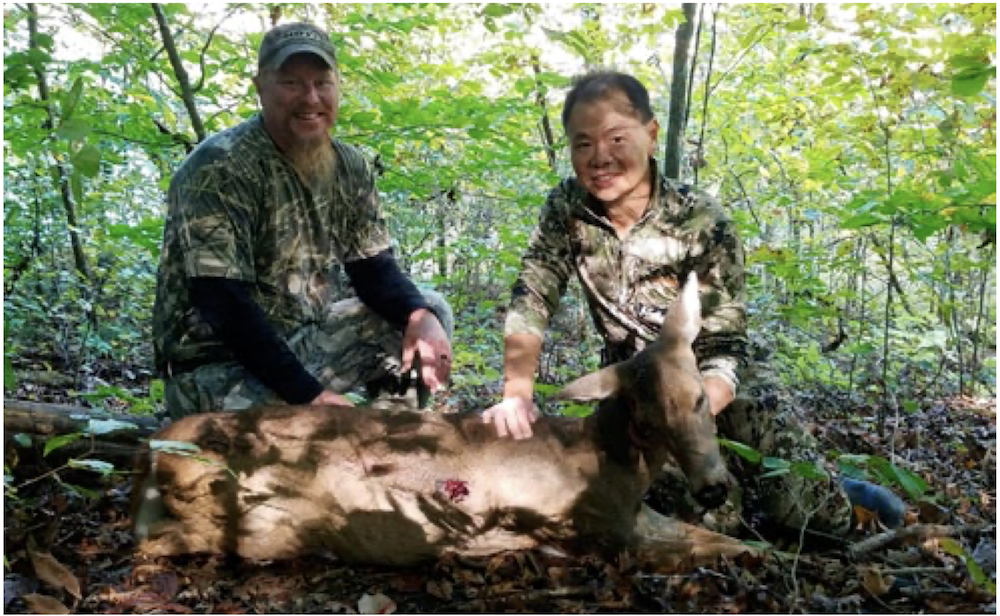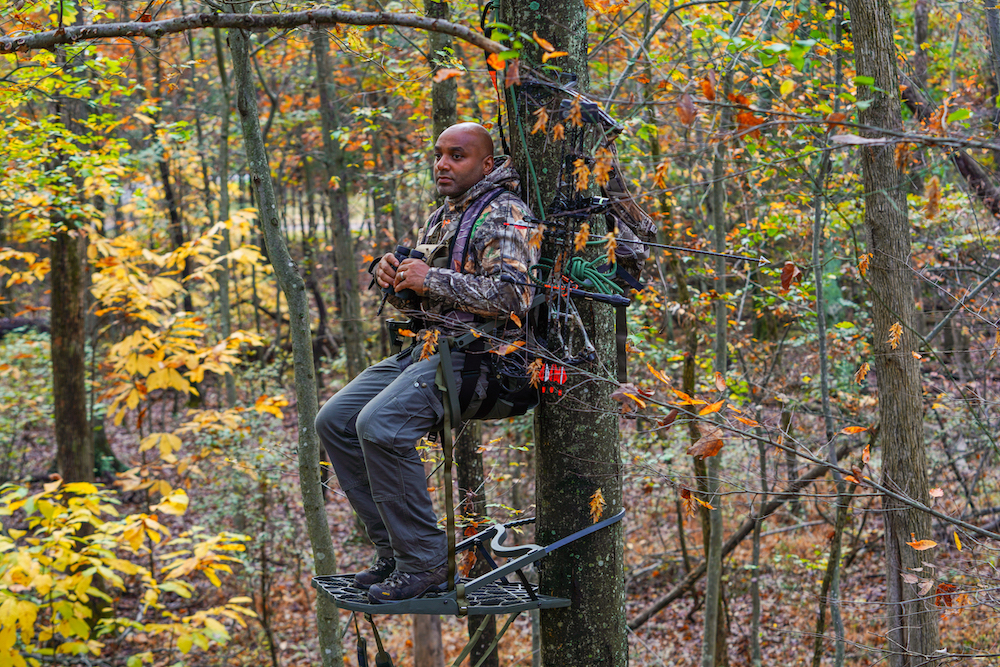When you look at the forest, it’s easy to overlook individual trees. They may be growing all around you, ranging in size from 2 inches to 80 feet tall, but if you’re not taking the time to learn the differences between the trees in your area, you’re not seeing as much of the forest’s big picture as you could be. And if that’s the case, you’re not being as effective at bowhunting as you could be, either.
Most Eastern whitetail hunters climb trees to hunt for deer. Trees also drop hard and soft mast, like acorns and apples, that deer love to eat. They provide cover, serve as landmarks, offer great backrests when you need to stop for a break, and are integral parts of the hunting pursuit. Without trees, hunting would look a lot different. So, why don’t more new bowhunters know how to identify different tree species and use them to their advantage?

We spoke to Scott Crume to find out. He’s a lifelong bowhunter who teaches educational workshops for the Kentucky Department of Fish and Wildlife Resources’ Field to Fork program, designed to teach adults with a nonhunting background how to hunt. He teaches beginners about bowhunting, land navigation, wild animals and woodsmanship skills, so they’re better prepared when afield.
Woodsmanship is the essential skill set of an outdoorsman or woman. It includes knowing how to build a fire, purify water, use a map and compass, and identify trees, plants, wildlife sign and terrain features. Crume said tree ID is an underrated skill and overlooked aspect of bowhunting that can lead to more success afield.
“(Tree ID) is difficult and it’s not glamorous,” Crume said. “Everyone wants to talk about scrapes, rubs, gear and all the cool stuff. Woodsmanship has taken a back seat to technology in some cases, but it’s where the rubber meets the road for most folks, especially for a public-land hunter. It’s incredibly important.”
Crume said it’s easy to get caught up in new product marketing efforts, but gear can’t buy success. The cheapest and best thing newcomers can do, he said, is educate themselves. Focus your time on learning, not your money on products.
Learning to identify trees is a free skill, and it’s just as effective as a trail camera at helping you find deer. Spoiler alert: Deer will be where there’s food — and trees produce many food sources. Plus, knowing which species of trees are the safest to climb helps ensure you’ll be around to locate and hunt deer for a long time. Hunting out of certain trees can be dangerous and put you at a higher risk for an accident.
Crume shared his tips for identifying trees that provide food or are suitable for a treestand. Please note tree species vary by region.
The easiest ways to identify trees is to recognize their mast (the nut or fruit produced), study the leaves and look at the bark. Crume said most trees have visible mast by September, so late summer and early fall are the best times to learn.
“Learning the fruit or mast and then the leaf is a good starting part for most people,” Crume said. “That’s the easiest way. Evolve from there to look at the bark, the structure of the tree or where the tree is growing for the advanced course. Remembering this stuff is the hard part. It takes time, but you’ll get to a point where if a tree doesn’t have fruit or leaves (because trees lose their leaves in winter and not all trees bear mast annually), you can still ID it from the bark.”
For example, if you see an object in the canopy that looks something like a green tennis ball, you might be looking at a walnut tree. Study the leaf and bark to find unique characteristics. A walnut tree bears long central stems or blades with two to nine pairs of feather-shaped leaves on each stem. The bark is hard and rough, and it has deep cuts that zigzag vertically. Use a resource such as an app or a plant ID book to confirm your findings. Approach tree ID as a progression, and don’t rush the lessons. You won’t learn everything overnight, and you’ll make mistakes along the way.
When it comes to deer food sources, trees fall into two categories: hard mast (oak, chestnut, pecan, hickory, beech and other nut-producing species) and soft mast (fruit-bearing trees like apple, crabapple, plum, persimmon and pear).
Crume said oaks are the best trees to learn first. “Acorns are a pretty big draw for deer,” he said. “Deer will eat beech and hickory nuts, but they won’t walk past acorns or other food sources to get them. Most people can find oaks wherever they’re hunting so they’re an easy tree to learn.”
The oak family is large, and each species has unique features you’ll learn along the way. Crume said trees in the white oak family have leaves with smooth, rounded tips, whereas trees in the red oak family have pointy, bristle-tipped leaves. An oak’s leaves are typically about 4 inches long and have three to five symmetrical lobes. The bark on a white oak is light gray or “white” and has a papery feel. It’s soft but sturdy. Red oak bark is darker, harder and furrowed with deep grooves.
Be advised: Some oak trees don’t produce mast every year, so if you don’t see acorns that doesn’t mean you’re not looking at an oak. Nature will trick you. Learn to identify different oak trees and branch out into other mast-producing trees.

Bowhunters should hunt from living, straight, sturdy trees to safely ascend and descend with gear and a stand and harness. Trees should also be easy and quiet to climb, which allows hunters to be stealthy. The foliage or mast doesn’t matter much for identifying ideal trees to climb. Instead, look at the bark. Crume’s favorite tree to climb is a white oak, followed by poplar, cedar and pine. Red oaks and maple trees are his backup options if nothing else is around.
“A white oak is one of my favorite trees to climb,” Crume said. “The nature of the bark is great for climbing stands. It’s soft enough to grab the stand but not so soft that it falls off the tree.”
Most poplar trees have a smooth, silvery-gray colored bark with small horizontal marks, called lenticels. The tree trunks are very straight. Tulip poplars are common in the east. Their leaves are short with four lobes and smooth edges. These, along with cedar, pine and maple trees, allow the treestand “teeth” to bite into the tree, making it secure. Cedar trees have hairy-looking bark that peels off in strips. The trees also have many low branches that aren’t suitable for climbing treestands. However, they provide great cover and stability for lock-on stands. Pine trees have distinctive needles, which give away their identification, but there are many species. Their bark is flaky and soft. They’re great to climb from a safety standpoint, but they’re loud and can cover your stand in sap.
Crume said hickory, cottonwood, ash and sycamore are trees to avoid because their bark causes problems with treestands. Hickory trees have scaly bark that curls and peels off the tree and falls when disturbed, making them difficult and noisy to climb. Cottonwood and ash tree bark is tight but thick, with deep ridges that cause treestands to slip. Maple trees can have similar bark as they age. Sycamore tree bark is almost nonexistent, Crume said. It’s thin with no structure and too slick for a climber, so he avoids them at all costs.
When picking a tree to use with a climbing stand, don’t forget about the tree’s size and taper. Small trees are dangerous to climb because they sway in the wind, and your movements might shake them on calm days. Especially big trees are also dangerous to climb because it can be difficult to move and secure your stand around large-diameter trunks. Treestand manufacturers set a minimum and maximum tree diameter for climbing stands. Check the instructions for specifics. The best trees have 12- to 18-inch diameters. Account for the tree’s taper when you install your climber, too. Crume said it takes practice to get the angle of the stand platform at the bottom of the tree just right so it’s level at your hunting height. Generally, you want the platform angled up at the bottom of the tree, where it’s larger in diameter, so that it levels out higher up in the tree, as the trunk decreases in diameter.
Ready to identify trees to find food sources and ideal climbing trees? Check your app store for free plant and tree ID apps. You can also get a tree ID book from the library or bookstore. Your county extension office and its agents are also probably well versed in tree ID. Stop by for a lesson or ask them for resources. They’ll teach you about the species in your area, so you can skim over the stuff you don’t need and get straight to learning about the good stuff.